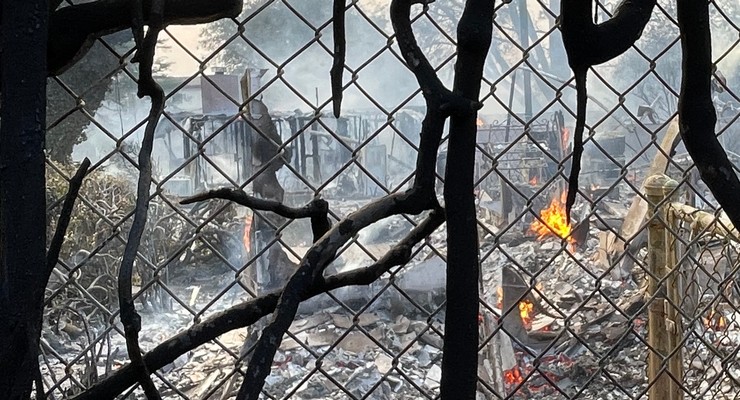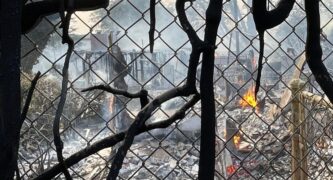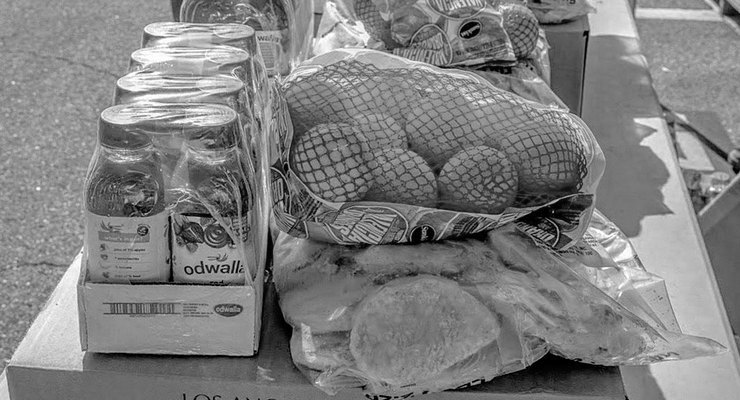
Southern California Edison launched a voluntary compensation program on Wednesday for survivors of the deadly Eaton Fire, promising payments within months while facing accusations that its offers fall short of what victims deserve and surrender too much control to the utility itself.
The program, announced October 29, comes nearly ten months after the January 7 wildfire that killed 19 people and destroyed 9,414 structures in Altadena and surrounding areas of Los Angeles County. The fire burned 14,021 acres before being declared fully contained on January 31.
The compensation initiative arrives as Edison confronts multiple lawsuits, including one filed in September by the U.S. Department of Justice seeking more than $40 million for fire suppression costs and environmental damages.
Los Angeles County, Pasadena and Sierra Madre filed separate suits in March seeking hundreds of millions of dollars for infrastructure damage and emergency response costs.
The utility’s overt acknowledgment of potential responsibility came just one day before the program’s launch.
On October 28, Pedro Pizarro, president and CEO of Edison International, stated in the company’s third-quarter earnings report: “SCE is not aware of evidence pointing to another possible source of ignition. Absent additional evidence, SCE believes that it is likely that its equipment could be found to have been associated with the ignition.”
That statement followed months of investigation into the fire’s origins. Edison reported to the California Public Utilities Commission that a fault was detected on its Eagle-Rock-Gould transmission circuit at approximately 6:11 p.m. on January 7—seven minutes before the fire ignited near Altadena Drive and Midwick Drive. The fault caused an increase in current on transmission lines including towers M6T1 and M24T3 in Eaton Canyon.
A February 6 letter from Edison to regulators noted that photographic evidence showed “signs of potential arcing and damage on the grounding equipment” on transmission towers in Eaton Canyon, and that an idle Mesa-Sylmar transmission line that had been decommissioned over 50 years was “inexplicably re-energized.” Video footage and photographs captured flames at the base of Edison transmission towers moments after the electrical fault.
The National Weather Service had issued multiple warnings for extreme fire weather in Los Angeles County in the days before the fire started. The official cause of the fire remains under investigation by Cal Fire as of October.
A Program Designed for Speed
Edison’s compensation program offers survivors two pathways to settlement. The “Fast Pay” option promises an offer within 90 days of what the utility deems a “substantially complete submission,” based on standardized formulas using property valuations from Compass Lexecon, an economic consulting firm. The “Detailed Review” option provides a more comprehensive evaluation of individual losses, with offers extended within nine months.
Edison alone determines when a submission is complete, affecting when the 90-day clock starts.
The program makes payments available for destroyed homes, damaged property, personal belongings, vehicles, emotional distress, temporary living expenses, and lost income. Eligibility was expanded to include nearly 6,000 properties that suffered smoke, soot or ash damage without being burned—expanding the total eligible properties from approximately 12,000 in the September draft to nearly 18,000 in the final program.
The compensation structure includes specific payment tiers. For deaths, the program offers a $5 million direct claim premium per deceased individual, plus pain and suffering compensation and economic damages. For destroyed primary residences where owners occupied the property, the program provides a $200,000 direct claim premium, $115,000 per adult for emotional distress, $75,000 per child for emotional distress, plus rebuild cost compensation based on pre-fire property value minus post-fire value. Owner-landlords receive a $150,000 premium for destroyed primary structures.
Renters receive $50,000 per adult for destroyed primary structures—an amount survivor groups claim is split among all residents and inadequate for actual losses. Properties with smoke, soot or ash damage receive $20,000 per adult and $5,000 per child for non-economic damages, plus $10,000 per structure for property damage. Survivors claim actual smoke remediation costs run between $50,000 and $150,000.
To design the program, Edison consulted Kenneth Feinberg, who served as Special Master of the September 11th Victim Compensation Fund, and Camille Biros, a compensation fund expert who partnered with Feinberg. The RAND Corporation, an independent nonprofit, evaluated Compass Lexecon’s valuation methodology and published its findings when the program launched, concluding that “the data and methods that were used to estimate the pre-fire value, post-fire value and diminution in value for single-family residences destroyed in the Eaton Fire were broadly appropriate.”
Feinberg characterized the program as “designed to be transparent, swift and sensitive to the needs of those affected.” Biros added: “Our goal is for every participant to receive appropriate compensation without the delays, costs and uncertainties of litigation.”
But participation requires significant concessions. Accepting an Edison settlement means signing a release waiving the right to sue the utility. No negotiation is allowed on the offers. Payment arrives within approximately 30 days after Edison receives a signed, notarized settlement agreement from all required parties. The program is not an admission of legal liability or wrongdoing, and Edison reserves all legal rights and defenses.
The program is voluntary, requires no fees, and claimants can participate with or without an attorney. However, Edison controls the entire program with no independent oversight or neutral third-party administrator—a structure that has drawn sharp criticism.
A contentious issue involves insurance coordination.
According to the program protocol, detailed review offers will be reduced by insurance coverage amounts, while Fast Pay offers will not be reduced by insurance claims. However, survivor groups claim Edison will deduct full insurance policy limits even if actual payments were lower—for example, if a home was insured for $600,000 but the insurer only paid $200,000, Edison would still deduct $600,000. The exact insurance offset methodology requires clarification through review of actual settlement agreements.
“Indefensible” Compensation
The Eaton Fire Survivors Network, a 2,000-member advocacy group formed in early 2025 that evolved from a WhatsApp pickleball group, has emerged as the program’s most vocal critic.
On October 8, the organization published “Fix What You Broke,” a 51-page report compiled from more than 200 survivor accounts that challenged Edison’s draft compensation plan.
Joy Chen, the network’s executive director and a former deputy mayor of Los Angeles, delivered a scathing assessment of Edison’s approach.
“This isn’t about blame — it’s about fairness and reasonableness,” Chen said. “We call on Edison to honor its moral and legal duty to fix what it broke. Edison’s draft plan would pay most Eaton Fire survivors only a fraction of what PG&E paid its Camp Fire victims — and PG&E was bankrupt. Edison is solvent, profitable, and backed by the California Wildfire Fund. For it to offer less than a bankrupt company did is indefensible.”
The survivor network’s “Fix What You Broke” report outlined seven specific concerns: insufficient compensation compared to PG&E’s Camp Fire payments despite Edison’s solvency; program mimics insurance tactics with exclusions and limits courts have rejected; inadequate smoke damage coverage; children undervalued with lower emotional distress payments than adults; renters excluded or underpaid with many outside the fire perimeter excluded and inadequate personal property coverage; no independent oversight with Edison controlling eligibility, valuation and administration; and unfair insurance offsets that deduct full policy limits even if actual insurance payments were lower.
Andrew Wessels, the network’s strategy director, characterized the program’s intent more bluntly: “It’s to pick off the most vulnerable in our community who need money the fastest.”
The survivor network’s advocacy appears to have influenced the program’s final form. Edison held four community workshops in late September—two virtual and two in-person at Loma Alta Park in Altadena—and the utility reported making more than 50 updates to the program based on survivor feedback.
Pizarro acknowledged the community input: “We listened to more than a thousand voices and learned what matters most to those impacted by the Eaton Fire: clarity, fairness and speed. This input helped SCE refine the program to respond directly to the community’s needs.”
The company increased child compensation by 50 percent from $50,000 to $75,000, doubled non-economic compensation per child for other impacted properties, eliminated additional documentation requirements for certain non-burn damage and landscaping claims, and increased monthly fair rental value calculations by 17 percent. Pizarro noted that “expanding the eligibility area is one of the most significant updates made as a result of feedback. The number of qualified properties nearly doubled for those with damage from smoke, soot or ash.”
Still, the utility acknowledged that not every request could be accommodated. Additional community sessions are scheduled for November 1 at John Muir High School in Pasadena and November 5 via virtual workshop.
Mounting Legal Pressure
While Edison pursues its voluntary compensation track, the utility faces a growing constellation of lawsuits that could ultimately dwarf any settlement payments.
Los Angeles County filed suit on March 5, seeking what Dawyn Harrison, the county counsel, described as “at least hundreds of millions of dollars” for infrastructure damage, emergency response costs and cleanup.
Harrison stated: “We are committed to seeking justice for the Altadena community and the taxpayers of Los Angeles County.” The cities of Pasadena and Sierra Madre filed separate suits the same day for damages to police facilities, water infrastructure, municipal buildings, public lands and trail systems.
Robert Parkhurst, mayor of Sierra Madre, emphasized the preventable nature of the disaster: “What makes this disaster particularly troubling is its preventability. The documented weather warnings provided Edison with ample notice of the dangerous conditions developing in our community.”
The federal lawsuit, filed September 4 by Acting U.S. Attorney Bill Essayli of the Central District of California, takes direct aim at Edison’s safety record.
“The lawsuits filed today allege a troubling pattern of negligence resulting in death, destruction, and tens of millions of federal taxpayer dollars spent to clean up one utility company’s mistakes,” Essayli said in announcing the action.
The litigation landscape extends beyond government entities. Multiple private lawsuits have been filed by individual survivors and families of those who died in the fire. The death toll, initially reported at 17, rose to 19 after human remains were discovered in August.
Attorney Kipp Mueller, representing fire survivors, summarized the dilemma facing claimants: “In nearly every instance, the compensation offered is a mere fraction of what we might—though not with certainty—recover through litigation.”
For survivors weighing Edison’s compensation offers, the voluntary program presents a calculated risk: accept a payment now and forfeit the right to potentially larger damages through litigation, or reject the offer and face years of legal uncertainty with no guarantee of a better outcome.
Edison maintains that the program provides faster resolution than litigation. The utility established a dedicated website, sce.com/directclaims, where survivors can learn about the program and submit claims. Legal representation remains optional under the program structure, and Edison has indicated it will provide a 10 percent supplement to the net damages portion of offers to help address legal costs—though many attorneys typically charge 25 to 40 percent contingency fees, making the supplement potentially insufficient.
Edison’s financial structure for wildfire claims draws first on a $1 billion customer-funded self-insurance account. Claims exceeding that amount are reimbursed by the California Wildfire Fund, which has an estimated $22 billion available. Pizarro stated this should be “sufficient to reimburse the company” for Eaton Fire claims. The wildfire fund administrator has confirmed the Eaton Fire as a covered wildfire.
The Altadena community that bore the brunt of the Eaton Fire’s destruction continues to grapple with recovery nearly a year after the flames swept through.
The fire destroyed schools, parks, churches, businesses and critical municipal facilities in addition to thousands of homes. More than 1,000 additional structures suffered damage.
For many survivors, Edison’s compensation program represents a crossroads: the promise of relatively swift financial assistance measured against concerns about adequacy and fairness, all requiring the surrender of legal recourse against a utility that has acknowledged its equipment likely played a role in igniting one of the deadliest wildfires in California history.
As the claims portal opened this week, thousands of Altadena residents face that choice with the memory of January 7 still fresh—a Tuesday evening when hurricane-strength winds and an electrical fault combined to set their community ablaze.


















